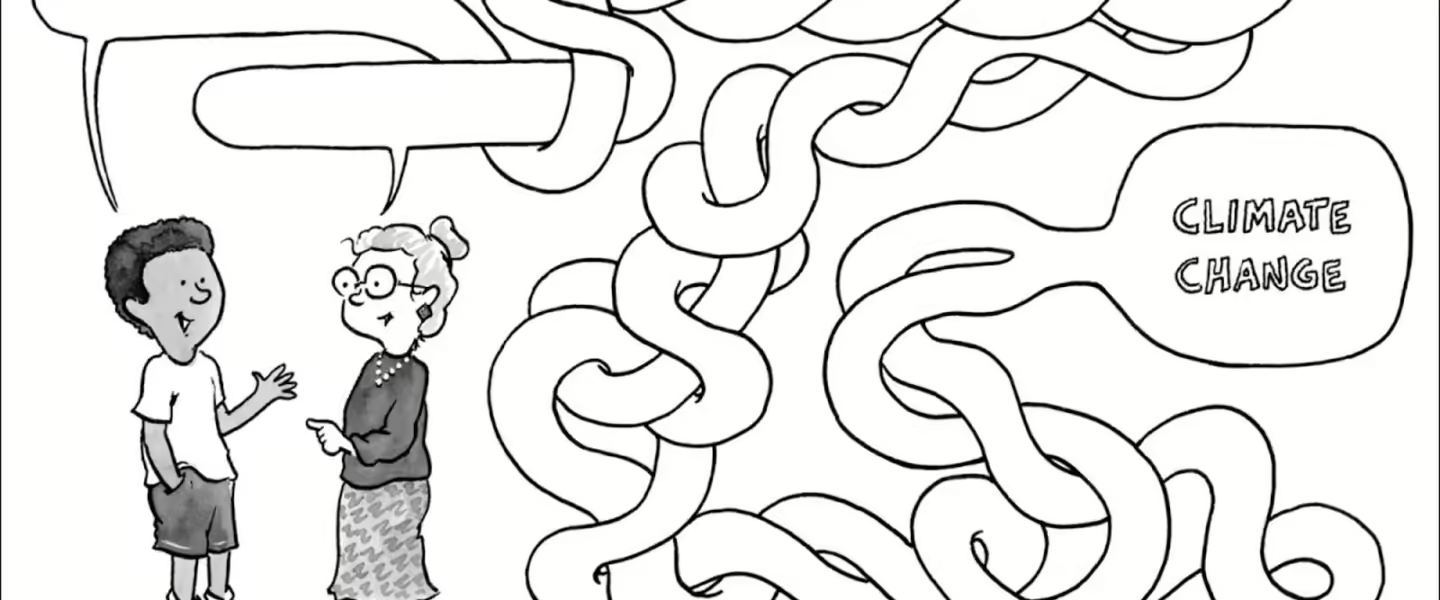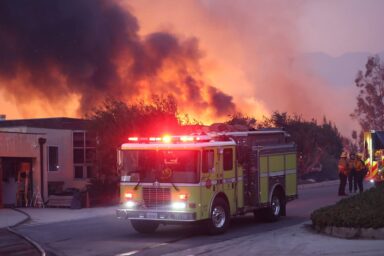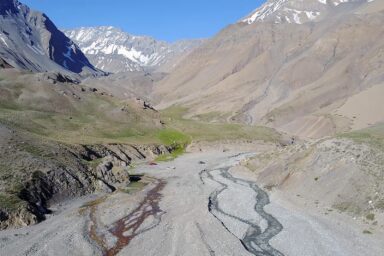These tips can help you connect with friends, family, and strangers.
|
Listen To This Story
|
Climate change may not officially be on the ballot this November, but the climate and energy policies of the two major parties couldn’t be further apart. President Joe Biden has taken a number of historic steps toward a clean energy economy. While far more needs to be done, a Trump victory “would become an all-out assault on any possible progress on climate change,” according to Pete Maysmith of the League of Conservation Voters.
For people who are concerned about how the election could affect climate action, one of the most effective ways to have an impact is by talking about it with other voters. Here are some tips for how to talk about the climate stakes of the 2024 election with friends, family, and neighbors.
Start by Listening
In her more than two decades as director of the Sierra Club’s chapter in purple-state Arizona, Sandy Bahr has plenty of experience talking with voters from across the political spectrum about the impact elections can have on climate policy. The most important advice she has for these dialogues is the one most frequently neglected.
“A big part of a conversation is listening,” she says. “What do they think about climate change? You have to know where the other person is coming from to move the conversation forward.”
Jane Conlin, co-leader of the Citizens’ Climate Lobby in Tucson, agrees. “You have to approach people with an open mind and with respect.” People don’t want to be lectured to.
“We always begin by searching for common ground,” explains Conlin. “It’s just talking about the things that you see and experience every day. There are so many ways to have a conversation because we know that climate change is affecting every aspect of our lives.”
All Climate Politics Is Local
Where people live determines what they care about most. In Arizona, for example, nearly everyone is concerned about water. In rural areas, the issue may be agriculture.
“Ranchers and farmers know that there’s less water coming down the Colorado River,” Bahr says.
In the southern part of the state, the Sonoran desert, the fast-growing urban centers have long relied on the Colorado River and on groundwater, which, Bahr says, is shrinking due to both over-pumping and slower recharging from a decreasing amount of rainfall.
“Not all water issues are attributable to climate change,” she points out, “but it’s making a situation that was already bad much worse. So leading with water is a good way to connect with people here.”
No place is immune from extreme weather linked to the changing climate, as demonstrated by 2023, the warmest year for the planet in recorded history. Along the Gulf Coast states, climate change is causing sea level rise and more powerful and more frequent hurricanes. Last year, triple-digit temperatures across the Plains States to the southeastern US in August were associated with the formation of massive heat domes linked to hundreds of deaths. Increased humidity from a warming ocean fed “atmospheric rivers” causing massive destruction across the West Coast. For weeks, the northeastern seaboard was blanketed with smoke from Canadian wildfires exacerbated by climate change. Whatever form weather extremes took, the people who lived through them won’t forget their impact and will likely be eager to talk about them.
Talk About Electrification
Because over 75 percent of climate change is caused by burning fossil fuel for power, electrifying the grid and transportation is critical to a sustainable future. Fortunately, transitioning to a clean energy economy offers a variety of issues that are engaging.
As Sandy Bahr points out climate change “is a pocketbook issue. Even if it’s just higher prices for electricity, that’s a big concern for almost everybody.”
With the cost of solar panels dropping by 85 percent over the last decade, Conlin says that clean energy is a hot topic in Tucson, where residents experienced a record 14 days of 110-plus-degree temperatures last summer.
“We talk about the economic benefits of installing solar panels because people already have sky-high electricity bills from air conditioning in the desert. And then we can talk about voting for candidates in November who support clean and cheap energy.”
Electrification on such a massive scale is pushing technological innovations that fascinate people regardless of their politics. Conlin recalls a discussion she had recently with a man doing maintenance work on her house.
“He was interested in new technologies so I showed him my induction stove. I didn’t tell him the climate reasons for getting the stove. I just showed him how fast it heated water through magnetism.”
He was enthralled. When the conversation moved to cars, Conlin asked if he’d ever seen an electric vehicle up close.
“He had,” she says, “and he talked about how cool they are.”
Conlin’s under no illusion that the conversation will necessarily move the man to vote for climate-positive candidates.
“But,” she says, “I am hopeful that he has become more receptive to hearing about a transition from fossil fuels to an electricity-fueled economy. We expanded the conversation from the stove to cars to just, you know, how electrons are our friends! It’s an example of meeting people where they are and moving them along.”
Provide an Antidote to Feelings of Powerlessness
“With climate change, sometimes people feel a bit helpless and that creates inaction,” Bahr says. “It’s not always that people don’t care. It can be that they’re just overwhelmed.”
Even small actions can be an effective antidote to feelings of powerlessness, she says, pointing to a provision of the Inflation Reduction Act that provided millions of dollars for a program in Phoenix where volunteers plant shade trees to make the city more livable as temperatures increase.
“Things like the tree-planting program,” Bahr says, “where people can go out and physically do something, helps them overcome that feeling of helplessness. It can be a powerful motivator to get involved.”
That personal participation can lead to voting for candidates who understand the issues and provide solutions.
How To Talk to Young Voters
All the above points hold for talking with younger voters, but there are additional factors to take into consideration, says Taylor Conley, an 18-year-old high school senior and climate activist in Tempe, AZ.
“Personally, I’ve always felt a lot of concern about Arizona’s changing climate,” Conley says, “especially the worsening heat. So when a neighbor brought me to the Youth Climate Strike at the state capitol building in March 2019, I really liked both the community of youth there and the opportunity to do something to help the climate.”
Conley joined the Arizona Youth Climate Coalition and while helping organize events she had an epiphany.
“I realized I could actually have an impact,” she says. “I discovered that there’s power in working with others.”
Today, Conley codirects the Arizona Youth Climate Coalition, where her duties include talking with other students about voting for climate policy. It’s not always an easy conversation.
“A lot of kids are just absorbed in what they have going on in their lives right now,” she says, “and they don’t really want to think about it.”
Others know that climate change is real but they don’t believe that they can have an effect. When speaking with them, Conley brings up Tucson’s climate action and adaptation plan and mentions that Arizona Youth Climate Coalition’s Tucson team helped write the plan.
“Some of those students are surprised by what we’ve already accomplished. It’s empowering and it can lead to the next step: voting for candidates who support policies that align with our values.”
Conley, Bahr, and Conlin are all gearing up for the November election, and each is optimistic that a combination of proper messaging and hard work will lead to decisive action on climate policy.
“It’s a scary time for the environment,” says Bahr, “and a scary time for our democracy. But I don’t believe in trying to motivate people out of fear. I hope that people will be motivated by love for their fellow humans, for their communities, and for the other creatures we share this planet with.”
However the conversation begins, Bahr personally believes climate change itself has to be part of the conversation for several reasons.
“Some voters may not be engaged on the issue of climate change because no one has taken the time to talk with them about it in terms they can understand,” she says. “People don’t care about what they don’t know.”
Bahr adds that because the pace of warming is increasing, climate change has to be addressed directly.
“We really need to get this ball rolling faster,” Bahr says. “We need to reduce emissions as rapidly as possible while we’re also making ourselves more resilient to the impacts of climate change. We can’t afford to wait.”
•
Tom Toro is a cartoonist and writer who has published over 200 cartoons in The New Yorker since 2010.
This story by Osha Davidson was originally published by Yale Climate Connections and is part of Covering Climate Now, a global journalism collaboration strengthening coverage of the climate story.





